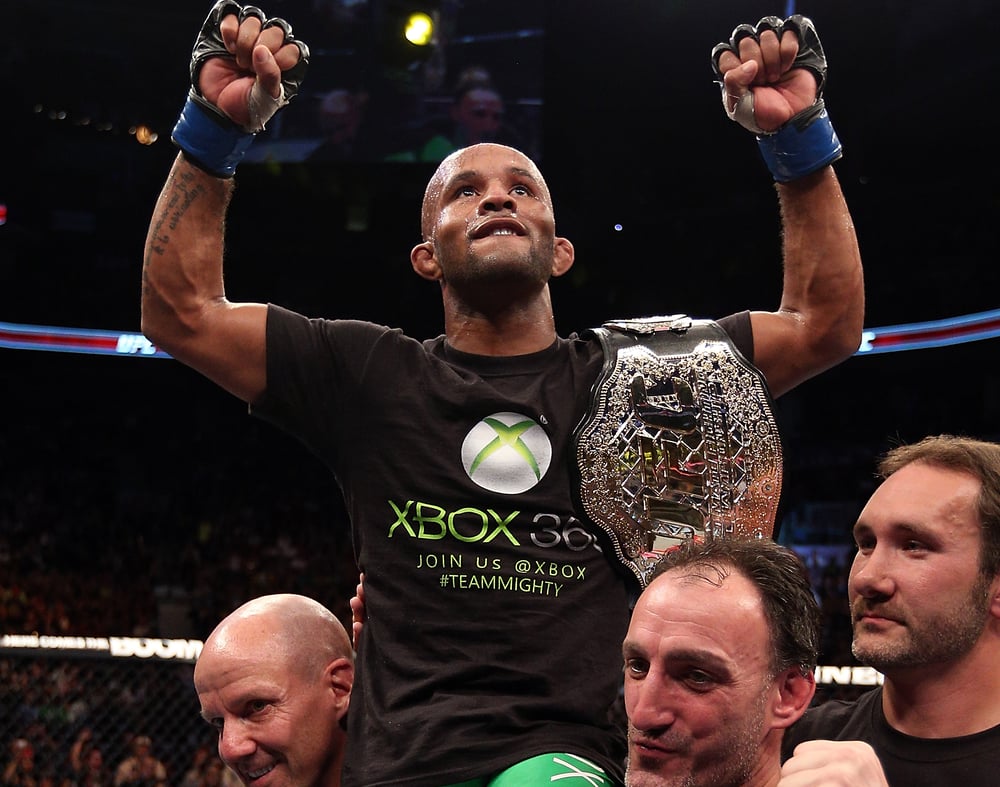
Issue 103
July 2013
Isn’t it time you started running your strength and conditioning regime like a pro?
In recent years, strength and conditioning has become one of the most important factors for top-level MMA fighters. However, it is still a misunderstood science. The specter of injuries and the spectacle of fighters gassing out inside the cage remain, but with decent management and proper communication they don’t have to.
One of the UFC’s quickest and most relentless competitors, Demetrious Johnson, knows a thing or two about pushing the pace in a fight and using his superior conditioning as a weapon. The 26-year old won the first-ever UFC flyweight championship in a series of brutally fast barnburners and continues to defend his title. Training under Matt Hume at AMC Pankration, Johnson has consistently displayed an amazing array of well-rounded skills inside the Octagon. Yet it is due to a proper fitness regime that ‘Mighty Mouse’ is able to engage in the kind of entertaining wars that have made him a champion. Part of that success is his work with Joel Jamieson, one of MMA’s most respected strength and conditioning coaches, and how the team of trainers helps, supports and manages Johnson’s preparation on his way to the cage.
“A strength and conditioning program provides a fighter with the foundation to use the skills he has learnt over years and years of being a martial artist,” explains Joel. “At the level of the UFC, an athlete needs a high level of fitness to recover from the training and sparring he does throughout the week, and he or she will also need a high level of conditioning to compete inside the cage. At the amateur level, as guys are coming up in the sport, that is when you build the foundations of fitness, of explosive power and endurance. For the amateur, the most important thing is to be working on a basic level of strength, a basic foundation of conditioning as well as developing the nervous system to be explosive. This is the time to be building the central cardiovascular functions because if you can stabilize these things in your younger years it will stay with you.”

Clearly a fighter like Demetrious, a former high school wrestler and athletics competitor, has those foundations in abundance. “Obviously, once you’re at the top it is a different ball game and your priorities shift as an athlete. The biggest thing we do as a team is to address any limitations that Matt Hume may have seen in Demetrious,” reveals Joel of the inner-workings of the flyweight champion’s fight camp. “Matt looked at DJ’s last opponent and realized that we needed to be more explosive. John Dodson is an explosive fighter. He’s not faster than DJ but we wanted to work on power and explosiveness. Our preparation then became about focusing on those areas and working Demetrious’ power punching and strength.”
For the professional mixed martial arts fighter there is a requirement to work constantly, to separate the fight camp from the off-season.
Joel says: “The off-season is where we find areas that need work. So, after a fight we’ll look at the performance and address the limitations that have become apparent. During camp we prepare for the particulars of the opponent, the rounds and time of the fight.” This is the period when a fighter focuses purely on the competitor ahead of him and ceases to be about learning new skills and developing as a martial artist. Instead the fight camp is about implementing the game plan - a crucial time for an athlete.
Working with Matt ‘The Wizard’ Hume, Johnson’s preparation has seen him time and time again put in almost faultless performances.
“Matt has been in the game for 30 years so he has a great sense of what needs to be done and what to work on. He’ll actually come and watch DJ’s strength and conditioning sessions, even taking part sometimes, so he knows what is going on,” Joel says. “I’ll give my input and Matt and I will talk and collaborate on what areas we need to work on and how Demetrious is responding throughout the camp.”

It is a big factor for Joel who has a holistic approach to his fighters. “There is a serious problem with coaching because some guys will have separate trainers for boxing, wrestling, BJJ and conditioning and none of them will talk to each other. So, you have an athlete who is working constantly and no-one is communicating but, obviously, they all want to give the guy a proper workout so he feels he’s getting the right attention. But what you end up with is a series of problems such as injuries and fatigue.”
Managing the S&C of a fighter like ‘Mighty Mouse’ comes down, then, to constant communication and an integration of all the parts that go into making a champion great.
“Matt and I are in communication daily, regardless of the time of year. We’ll go to each other’s sessions with DJ because it is one program that we are all following. It is absolutely about watching and assessing the fighter on a daily basis to see how he is reacting to the training and whether he is showing signs of fatigue. That way we know if we need to pull back on the intensity or not,” explains Joel. “We might have a program but it’s not set in stone. It all has to be based on what’s happening, even factors outside the training room like an athlete’s personal life become a factor. Fighters get over-trained and fatigued from a lack of communication between coaches and that is what leads to injuries.”
Managing a fighter’s training schedule is just as important as the work they put in sparring and drilling their skills or lifting and running. It is about seeing the athlete as an individual and monitoring him on a constant, daily basis to ensure they are on the right road. For Demetrious Johnson and the team of coaches behind him, that path led to UFC gold.
Joel Jamieson’s Keys to Successful Training
1 “Everyone is different, so the first important factor in any training is individualization. You have to consider an athlete’s genetics, their experience, their outside life and stresses. Demetrious and Tim Boetsch start out with similar programs but due to their responses things change.”
2 “Training has to be fluid. The program we write down is more a guideline than something concrete. It’s all about reactions and responses.”
3 “Implementing the proper recovery strategies is very important for each individual. For one guy that will be swimming, for another it is going in the sauna. It’s a little bit of trial and error, but the more you work with an athlete the better you get to know them and what works.”
4 “Nutrition is a huge factor. This has to be on point. If it is left down to the fighter it is a recipe for disaster. Getting the right amount of calories, carbs, protein and fats will dictate recovery times and therefore training.”
5 “Monitor the fighter. We use heart rate monitors, communication and just paying attention to the athlete. We’ll ask if they slept OK, if they’ve eaten; all the ways we can to measure and tailor the training to the fighter.”
6 “We use the high/low method with our fighters. Most fighters train in the middle somewhere and that ismno-man’s land. We train with intensity one day and then light the next, allowing the fighter to work on techniques and skills.”
7 “Finally, and most importantly, a cohesive program and communication is key. It means everyone is working from the same page towards the same goal.”
...










